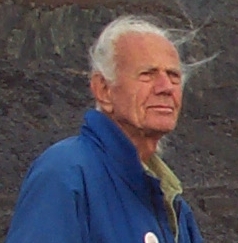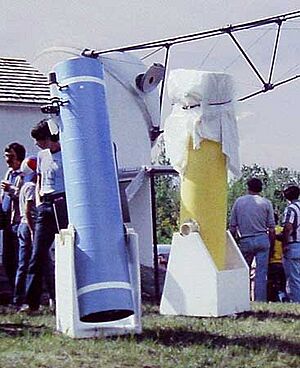John Dobson (amateur astronomer) facts for kids
Quick facts for kids
John Dobson
|
|
|---|---|

John Dobson in 2002.
|
|
| Born |
John Lowry Dobson
September 14, 1915 |
| Died | January 15, 2014 (aged 98) Burbank, California, U.S.
|
| Nationality | American |
| Education | M.S., Chemistry |
| Alma mater | U.C. Berkeley |
| Occupation | Vedantan monk (1944−1967), lecturer / popularizer of amateur astronomy |
| Known for | amateur telescope making, sidewalk astronomy, informal science education |
|
Notable work
|
Dobsonian telescope |
| Movement | Sidewalk Astronomers |
| Partner(s) | Dr. Ruth Ballard (geneticist) |
| Children | Loren Dobson |
| Parent(s) |
|
John Lowry Dobson (born September 14, 1915 – died January 15, 2014) was an American amateur astronomer. He is most famous for inventing the Dobsonian telescope. This telescope is special because it's easy to carry and doesn't cost much to build. It's a type of Newtonian reflector telescope.
John Dobson also worked hard to share his love for astronomy with everyone. He gave many public talks, often performing what he called "sidewalk astronomy". This meant setting up telescopes on the street for people to look through. He also helped start a group called the San Francisco Sidewalk Astronomers.
Contents
John Dobson's Life Story
John Dobson was born in Beijing, China. His parents were missionaries. When he was young, his family moved back to the United States. As a young man, he was very sure he didn't believe in God.
He earned a master's degree in chemistry. Later, he met a teacher from a Vedanta group. This group tries to mix old religious ideas with science and logic. John joined them and was a monk for 23 years.
After leaving the group, he traveled around. He taught people about amateur astronomy and sidewalk astronomy. In his later years, he reconnected with a Vedanta group in California. But he still spent most of his time promoting astronomy to the public.
Early Life and School
John Dobson's grandfather was a missionary. His mother was a musician, and his father taught zoology at a university. In 1927, John and his parents moved to San Francisco, California. His father became a teacher at Lowell High School.
When he was a teenager, John became a strong atheist. He felt that some religious ideas didn't make sense together. He explained that he couldn't believe in both "do unto others as you would that they do unto you" and "if you're not a good boy, it's into hell for keeps." He thought these ideas couldn't come from the same source.
Over time, John became very interested in the universe. He wanted to understand how it worked. In 1943, he earned a master's degree in chemistry. He studied at the University of California, Berkeley.
Time as a Monk
In 1944, John Dobson went to a lecture by a Vedantan teacher. He said this teacher "showed him a world he had never seen." That same year, John joined the Vedanta Society monastery in San Francisco. He became a monk in the Ramakrishna Order.
One of John's jobs at the monastery was to connect astronomy with Vedanta teachings. This led him to secretly build telescopes. He would roll them outside the monastery. Neighbors would gather around, fascinated by what they saw.
John built telescopes to better understand the universe. He also wanted to make others curious about space. He often helped people outside the monastery with their telescope projects. Building telescopes was not allowed at the monastery. So, he wrote his letters in code. For example, a telescope was called a "geranium". A "potted geranium" meant a telescope in its tube and mount. A "geranium in bloom" meant a telescope with a shiny mirror.
Eventually, John was told to stop building telescopes or leave the monastery. He chose to stop so he could stay. But one day, another monk wrongly accused him of being missing. This was reported to the head teacher. John was asked to leave in 1967. He believed the real reason was a misunderstanding. The head teacher read a paper that seemed to be by John. It seemed to go against the idea of science and Vedanta working together.
Sharing Astronomy with Everyone
After leaving the monastery in 1967, John Dobson helped start the San Francisco Sidewalk Astronomers. This group began in 1968 with Bruce Sams and Jeffery Roloff. Their goal was to make astronomy popular with people on the street. Bruce Sams had built a big telescope. But at 12 years old, he couldn't join the local astronomy club. So, the "San Francisco Sidewalk Astronomers" was created.
Around this time, John's simple telescope design became famous. It was later called the Dobsonian. He started teaching public classes on how to build your own telescope.
Later, he was invited to speak at the Vedanta Society of Southern California. He spent two months there each year. He taught classes on telescopes and the universe. He also spent two months at his home in San Francisco. The rest of the year, he traveled. He was a guest speaker for astronomy groups. He talked about building telescopes, sidewalk astronomy, and his ideas about the universe.
John Dobson's Ideas About the Universe
John Dobson believed that the Big Bang model wasn't completely right. Instead, he supported a different idea called a "recycling" Steady State model. In this view, matter in the universe is always expanding. But it also "recycles" over time through a process called quantum tunneling. In an essay called "Origins", Dobson wrote that this kind of universe could allow life to be everywhere, all the time.
Awards and Recognition
In 2004, the Crater Lake Institute gave John Dobson an award. It was for his excellent public service. He was honored for starting sidewalk astronomy in national parks and forests. This is where "curious minds and dark skies collide."
In 2005, Smithsonian magazine named Dobson as one of 35 people who made a big difference. This was during the magazine's lifetime.
His Passing
John Dobson passed away on January 15, 2014. He was 98 years old. He died at Providence / Saint Joseph Medical Center in Burbank, California.
How John Dobson Promoted Astronomy
The Dobsonian Telescope Design

John Dobson's biggest contribution is his improved design for a large, portable, and affordable reflecting telescope. This design is now known as the "Dobsonian telescope." It uses a very simple alt-azimuth mount for a Newtonian telescope. It's built with common materials like plywood, Formica, PVC pipes, cardboard tubes, recycled glass, and carpet.
This simple mount is often called a "Dobsonian mount" by amateur astronomers. Building telescopes this way makes them easy to move, cheap, very stable, and simple to make. It changed how big amateur telescopes could be. Before this, telescopes of such large sizes were rarely seen.
The design is named after Dobson because he was the first to combine all these building methods. Dobson himself didn't like to take all the credit. He said he built it that way because it was all he needed. He even joked that he was "too slow" to build a telescope with a more complex equatorial telescope mount.
Because it's simple to build and use, the Dobsonian has become very popular. Especially for large amateur telescopes. The Smithsonian National Air and Space Museum in Washington, D.C. uses a Dobsonian telescope in its public observatory.
Sidewalk Astronomers Group
John Dobson helped start the San Francisco Sidewalk Astronomers. He had built several telescopes that were cheap and easy to use. One was a 24-inch (610 mm) telescope that cost about US$300 to make. Instead of having regular meetings, the group simply set up telescopes on the sidewalk. They did this on clear evenings. They invited people passing by to look at the night sky and explained what they saw.
John often used a classic 9-inch Dobsonian telescope on the streets of San Francisco. It had a great mirror made by one of his students. This telescope was small enough for John to carry on San Francisco's public transportation. It was nicknamed "Tumbleweed" because it moved to many different public viewing spots. Now, this 9-inch telescope is shared among many astronomy clubs worldwide. This allows people everywhere to observe the sky with this special instrument, just as John Dobson wanted.
The Sidewalk Astronomers were invited to the 1969 Riverside Telescope Makers Conference. This was a surprise. The 24-inch (610 mm) Dobsonian telescope they brought was unusual. Most telescopes at these meetings were smaller. They were on equatorial mounts and used for astrophotography, not just looking through. Surprisingly, Dobson's telescope tied for first prize for best optics. It also won runner-up for its mechanics, even though its design was very simple.
Since then, Sidewalk Astronomers has become a well-known group. They are famous for bringing astronomy to the public through "sidewalk astronomy." The group now has members all over the world. They continue to promote public astronomy by setting up telescopes in cities. Members also visit national parks. They give presentations, offer telescope viewing, and explain the universe to visitors.
Books by John Dobson

In 1991, John Dobson and Norman Sperling wrote a book about building telescopes. This book helped make the Dobsonian mount very popular. It focused on why building telescopes is important, not just how to do it. The book also shared Dobson's background and his ideas about astronomy and the universe. He believed it was important for everyone to have access to astronomy to truly appreciate the universe. John Dobson also wrote two books about his ideas on cosmology.
John Dobson in the Media
John Dobson's life and ideas were featured in a 2005 documentary called A Sidewalk Astronomer. He also appeared in the PBS series The Astronomers. He was on The Tonight Show Starring Johnny Carson twice. John Dobson also spoke in Universe: The Cosmology Quest. This documentary was about different ideas on how the universe works.
See also
 In Spanish: John Dobson para niños
In Spanish: John Dobson para niños
- List of astronomical instrument makers
- 18024 Dobson

